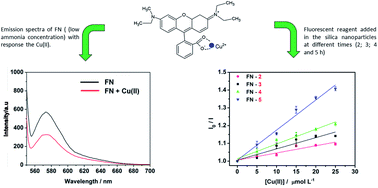Development of a reusable fluorescent nanosensor based on rhodamine B immobilized in Stöber silica for copper ion detection†
Abstract
This work has the goal of developing and evaluating a reusable fluorescent nanosensor for detection of Cu(II) ion in aqueous solution, based on the immobilization of rhodamine B in silica nanoparticles prepared according to a modified Stöber method. In order to do this, a standard ammonium hydroxide ethanolic solution was mixed to ethanol under constant stirring, followed by the addition of tetraethoxysilane (TEOS). To immobilize the fluorescent reagent in the silica nanoparticles, rhodamine B ethanolic solution was added to the reacting mixture at different times (2; 3; 4 and 5 h) after starting the synthesis (which always lasts 7 h). The nanosensor obtained with the addition of rhodamine B after 5 h of synthesis showed the best sensitivity, measured as the fluorescence quenching, which was proportional to Cu(II) ion. The nanosensor was selective to Cu(II) ions and showed a linear range from 2.0 to 12.0 μmol L−1, detection limit of 0.40 μmol L−1, quantification limit of 1.3 μmol L−1, response time of 50 s, being possible to be reused 3 times. The nanosensor was applied to the determination of Cu(II) in sugar cane spirit and the results obtained did not show significant differences from those obtained by atomic absorption spectrometry at a confidence level of 95%.



 Please wait while we load your content...
Please wait while we load your content...